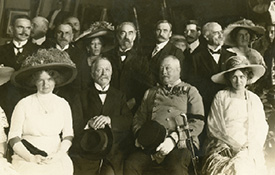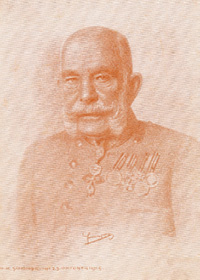Israeli Scene
Feature
The Kaiser’s Royal Artist
Urgent mail from Werner Sulzgruber: A work by David Kohn is listed for sale on the Internet.

Sulzgruber teaches history at a Gymnasium in Wiener Neustadt, the town in Austria in which I grew up and from which my family fled in 1938; until it was extinguished by the Germans, its Jewish congregation ranked among the largest and most eminent in Austria. A Catholic, Sulzgruber has taken on himself the community’s remembrance. He has written the definitive accounts of the community’s history and people, enlisted students in the cemetery’s renovation and led events to mark its thousand-year-old past and, then, its violent destruction. I have known and admired him for years. The son of the town’s last rabbi, I have remained in touch with the community’s survivors and helped expand his access to the stories of their lives.
Now, he has given me a tangible, new access to the story of the man whose name I carry: My mother’s father, Kaiserlich und Königlicher Hofmaler David Kohn—by appointment, Imperial and Royal Artist to the Hapsburg Court.
Born in 1861, David Kohn founded an academy of art in Vienna, the most prestigious of its time, and became one of the Austro-Hungarian Empire’s most gifted artists and, arguably, its most admired.
On special occasions, my grandmother would draw a brooch from its velvet pouch and let us children look at it. It was the most splendid thing I can remember from my childhood. Set on an oval disc of platinum, the letters made of diamonds spelled a dedication: FJ I zu DK I—Franz Joseph I to David Kohn I. “The Kaiser held your Grosspapa in great esteem,” Grandmother would say when she wrapped up the pouch, as if the largess of the gift had needed to be told.
More impressive than the blazing stones was what had led to that strangest of relationships between the absolutist Christian monarch of the greater part of Central Europe and the deeply pious Jewish painter. By the age of 8 or 9, I had accepted this simply as an item of my oral history: David Kohn letting the Kaiser know why he had to change a sitting scheduled by the court—it coincided with the intermediary days of Sukkot. Archduke Rainer arriving with an escort of mounted Hussar officers at the home of David Kohn in Baden for seudat shlishit, the third meal of the Sabbath. David Kohn and officers of the general staff. David Kohn and Viennese nobility. David Kohn, David Kohn…
I came across a memoir by Eugen Ketterl, the Kaiser’s chamber valet; in a chapter on the Kaiser and art, he wrote, “Kohn stood very high in his majesty’s grace, and the Kaiser told me repeatedly that Kohn is not only a great artist, but also, in the truest sense of the word, a noble human being.”
It’s my first chance in a long time to acquire one of Kohn’s works. His paintings and pastels are rarely on the market, and when one has appeared it’s taken within hours. I had waited too long on previous occasions—a day or two—to make an offer. The site on which this one now is listed was not available to me in Israel and it, too, shall slip through my fingers.
Only, it did not: Werner Sulzgruber intervened.
The picture is a farmyard sketch—horses, wagons, a dog, a farmer distant in the background—done in rötel, the red crayon that was Kohn’s signature medium. Exquisite in line and composition, the focus is on the horses, each intensely alive, each meticulous in itself and each the species’ paradigm. The initials D.K. on the lower right are superfluous—the style, technique and quality of the work speak for themselves.
David Kohn’s subjects spanned class and station—the court, nobility, the empire’s elite society through which he moved but never made his own, beggars and postmen and, his most inspired, the heads and figures of rabbinic sages and their students. His Jewish themes immortalized the universe of Jewish piety and learning and mirrored his own conviction.
Immersed in the belief and observances of the tradition, he was a founder of the Agudath Yisrael and a disciple of the Kopyczyner Rebbe in Vienna.
Complementarity between Orthodox Judaism and the visual arts was virtually unknown at the time, but it came naturally to Kohn. His father, a rabbi in the small towns of Lower Austria, also had artistic talent—a Sabbath song in calligraphy that he composed is framed above my desk—and encouraged his son’s career in art.

My grandfather knew no compromise with principle. For all the mutual regard that bound him to the House of Hapsburg, he published essay after thundering essay in condemnation of World War I; “humanity has sunk lower than it ever has before,” he wrote in 1916. His pacifism somehow, strangely, added to the respect accorded him by the country’s leading circles.
Much of his time and earnings were given to his passion: gemilut hasadim, charity and deeds. Sabbaths saw him in the wards of the Vienna General Hospital, visiting the sick. He founded a home for children orphaned by the pogroms in Eastern Europe and sustained the city’s Talmud Torah School; it was not beneath his dignity to go from door to door of wealthy homes entreating aid for their support.
He took ill one week in the winter of 1922. Only a slight fever and a bit of a cough, he insisted, nothing to keep him from his rounds. And the orphanage was in straits. Only two nights and then he would rest, he promised his physician. The weather was freezing. The third night, the fever shot up and he found it hard to breathe. He died the day after.
Sulzgruber alerted Helmuth Eiwen. the founder and pastor of an independent evangelic church in Wiener Neustadt that has sworn to stand by Israel and the Jewish people, Helmuth, a good friend, and his congregants come often to Jerusalem and to our home. On Helmuth’s request, the Dorotheum, Austria’s auction house for art, traced the picture’s provenance: no taint was found of theft or dispossession during the Nazi era. Helmuth acquired the picture in my name.
Last February, he brought his community to Jerusalem once again. After dinner and a ceremony at the Kings Hotel, the picture was placed into my hands, secured in a whitewood rack carpentered by Helmuth’s son-in-law.
David Kohn looks down on me from a rötel portrait by one of his students. Imperial and stern, he has followed me down the years, a legendary patrimony. Not always an easy one.
My mother never ceased to grieve his death, and grieve that I have not become a reborn compensation.
I have been told that I resemble him, and when I’ve run into people who knew him, a little awkward dance would take place—a step or two back, an uplifted face and outspread arms, a great surprise—and I would wonder if it wasn’t disbelief that the great man’s line had turned so quotidian.
At times, the encounter has been ethereal. Many years ago, I called on the venerable Rebbe of Kopycznic. He had fled Vienna and was living in a gloomy flat on the Lower East Side of New York. I bent to kiss his hand, and he pulled back. “No, not my hand,” he said. “Your grandfather’s hand. He shall be the high priest in the Temple.”
At other times, riotous. A restaurant in Soho, London, in the middle 1950s. I ordered chicken soup with kneidlach, leaned back in my chair and scanned the morning’s paper. Footsteps approached, undoubtedly the waiter’s, I thought, and I looked up. It was an older woman with a kerchief on her head.
“Maler Kohn!” she screamed, “Mein Gott! Maler Kohn!” and dropped the bowl, holding her hands to her face in shock. “You are his grandson, you are his Enkelkind.” She had been a cook in the Agudath Yisrael orphanage.
The picture of the farmyard has been hung in the one space in our living room not yet occupied by my David Kohn collection. A row of sages transfigured over holy texts, and then the horses at their wagons. The apposition fits. It was life that captivated him. Life in the posture of a man bent in devotion, life in the posture of a beast in acceptance of its mission. In his eyes, life was the sacred wonder in every form it takes.
Pace, Grosspapa.








 Facebook
Facebook Instagram
Instagram Twitter
Twitter
David Breuer Weil says
Hi there
My father always told me we were related to David Kohn (his grandmother was Jenny Kohn). I have 2 or three of his drawings in my collection too.
Chris Wares says
Hi David
Thanks for writing this. I have recently discovered that a relative of mine, coincidentally called Jenny Weiss, was once a pupil of your grandfather’s academy.
At the moment all I have as evidence for this is a record of her IKG emigration forms from 1938. https://www.myheritage.com/research/record-11000-68064-R11/ottilie-weiss-in-austria-vienna-jewish-emigrant-applications#fullscreen
I am now trying to find out more about David Kohn and his academy and found your webpage very helpful
Regards
Chris
anthony ROSINGER says
I have just had my grandmother’s diary translated and she says “He (my father) was often painted and sketched by the famous artist David Kohn in Rotel. This great artist tragically died just as he was working on my boy” I dont suppose anyone has a catalogue of his works – a dream come true to find a painting of my father as a boy?
Lilli says
Dear Anthony,
I wonder if David Kohn was a relative to Fanny Kohn, married Klumak. She lived from 1824 to 1914 in Vienna. Do you know more?
Thank you so much
Lilli